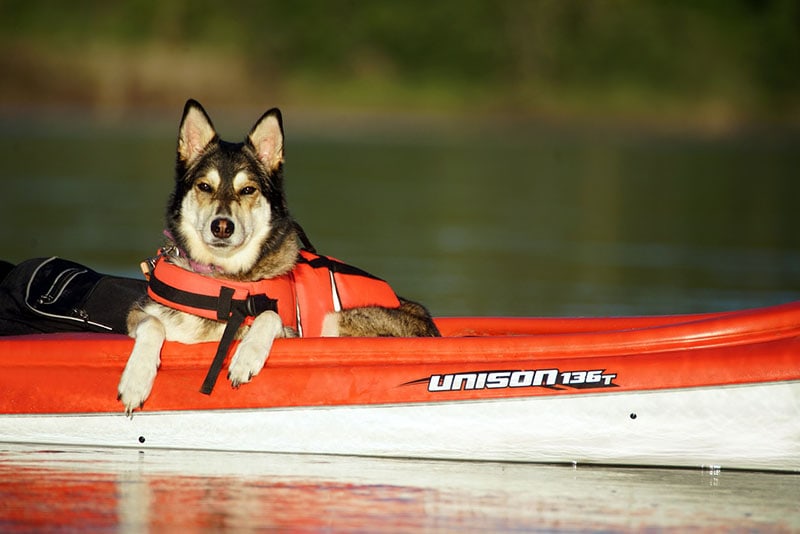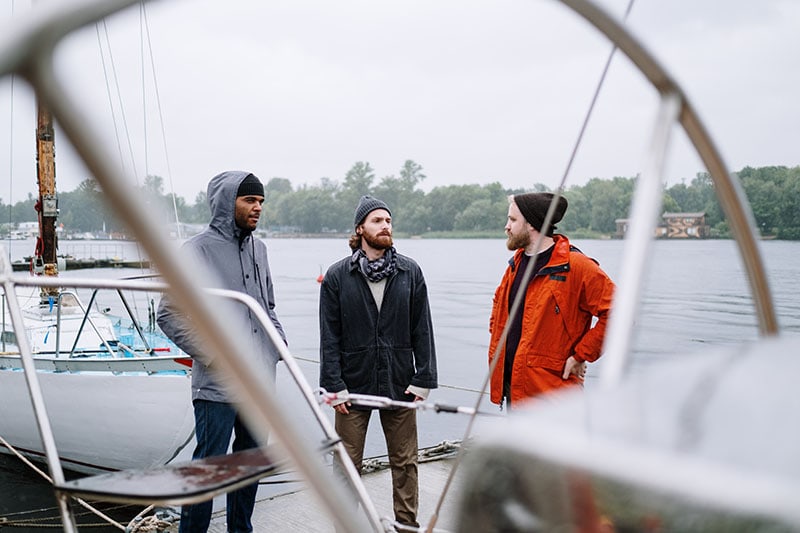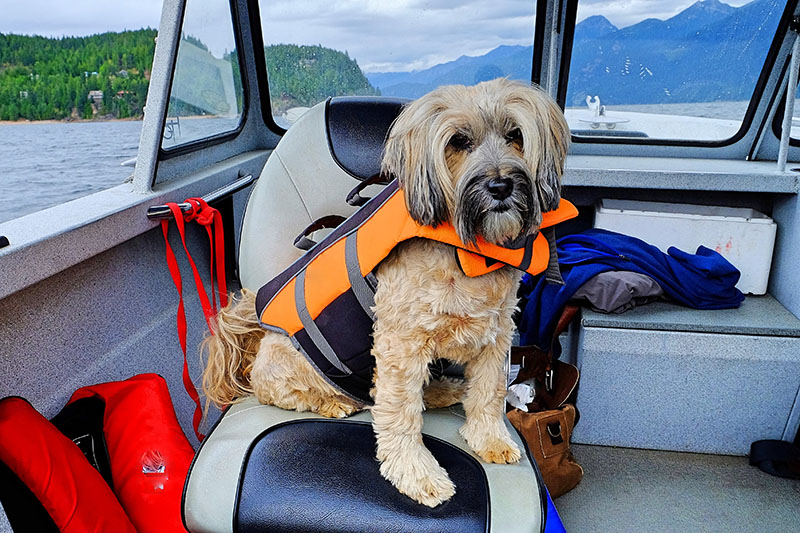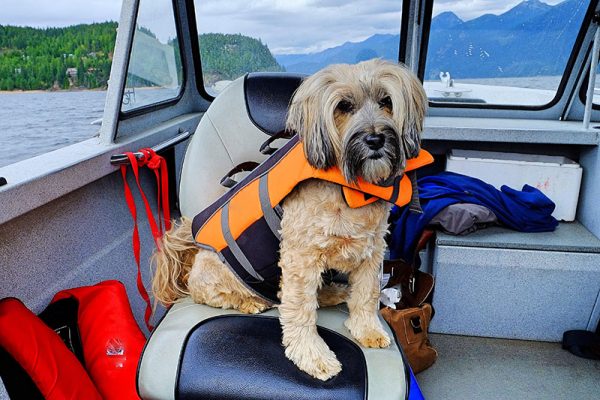If you’re a dog owner who loves to spend time on the water, you probably feel bad leaving your furry friend behind when you board your boat. However, with some precautions and training, many dogs can also learn to enjoy boating. Just as you follow specific safety protocols when you’re on a boat, there are ways to keep your pet out of danger too. Here are seven safety tips for boating with your dog.
The 7 Tips to Safely Go Boating With Your Dog
1. Introduce Your Dog to the Water First
| Quick tip: | Don’t assume your dog can swim |
| Helpful items: | Treats, leash, life jacket |
Before introducing your dog to a boat, take the time to get them used to water and ensure they’re comfortable with it. Not every dog enjoys water, nor can they all swim without training.
Never force your dog to play in the water if they seem reluctant. Instead, make it a positive experience by starting on the shore or dock and watching how they react, offering treats as needed. Some dogs won’t go on their own but may follow their owners into the water.
2. Get a Life Jacket

| Quick tip: | Measure your dog carefully |
| Helpful items: | Measuring tape, treats, floating leash |
Even if you discover that your dog swims like a canine Michael Phelps, you should still fit them with a life jacket whenever they’re on a boat. Accidents happen while boating; at the very least, most life jackets provide an easy way to grab your dog out of the water if necessary.
Check the dimensions of the life jacket you’re considering and measure your dog to make sure of a proper fit. You don’t want the jacket so loose it slips off or so tight it rubs your dog raw. Tighten the life jacket like you would a collar, leaving space for about two fingers to fit.
Replace your dog’s life jacket when it gets worn or frayed. You may also want to consider buying a floating leash, which provides another way to grab your dog if they go overboard.
3. Make Sure Your Dog Can Safely Get On and Off the Boat
| Quick tip: | Consider a ramp |
| Helpful items: | Treats, leash, ramp, or stairs |
Getting from the dock onto a boat can be intimidating for a dog, especially smaller ones. Even if your dog is small enough to lift onto the boat, teaching them how to do it themselves is a good safty step.
Suppose they get overly excited one day, try to leap on their own, and miss. Use treats and a leash to guide and encourage your dog to jump or step calmly from the dock or shore into the boat, repeating until they’re comfortable. If your dog is especially reluctant, consider buying a doggy ramp or stairs to make the process easier.
4. Keep Your Dog Comfortable

| Quick tip: | Give your dog their own “spot” on board |
| Helpful items: | Bed, water, dog snacks, toys, sunscreen, potty pads |
Help your dog get comfortable on board the boat by setting up a special spot for them, ideally in the shade. Consider placing a bed there or providing a favorite chew toy. Make sure your dog has access to plenty of water and snacks, depending on how long the boat trip will be.
Use dog-safe sunscreen on your pup’s nose, ears, and other bare areas. Teaching your dog to stay in one spot on the boat also reduces the chances that they’ll distract whoever is piloting the vessel. Make sure to plan for when your dog needs to do their business too. If you can’t go on-shore, keep potty pads onboard or make a potty spot with artificial grass for your dog to use.
5. Never Leave Your Dog Unattended
| Quick tip: | If you’re staying overnight on board, make sure your dog is secured |
| Helpful items: | Crate |
Whether swimming or boating, your dog should always be supervised when enjoying time on the water. You don’t want your dog bothering other boaters, swimmers, or wildlife. Discourage your dog from drinking water from the lake or ocean; saltwater can make them sick, and any body of water can contain parasites and bacteria.
Depending on where you’re boating, there could also be dangerous predators or venomous snakes lurking. If you’re living on a boat or sleeping there at least overnight, make sure your dog is safely secured before you go to sleep. Shut them in a cabin with you, or bring along a crate.
6. Make an Emergency Plan

| Quick tip: | Don’t jump in the water after your dog |
| Helpful items: | Floating leash, life jacket, |
Before you leave the dock with your dog, make sure everyone on board knows what to do in the event anyone, including your pup, falls overboard. Be alert to where your dog is at all times so you can react quickly if they end up in the water.
Circle the boat back to your dog’s location and turn off the motor if it has one. Grab your dog by the life jacket or leash to get them back into the boat. Don’t jump in after your dog for the same reason you’d need to be careful when trying to rescue a drowning person. Your dog could get scared, flail, or try to climb on you, putting you in danger as well.
7. Be Prepared
| Quick tip: | Check the weather |
| Helpful items: | First aid kit for dogs and humans |
As part of your pre-boating checklist, make sure you’re prepared in the event of a dog emergency. Keep the dog and human first-aid supplies on board. Know the weather report ahead of time to avoid being caught in a storm, especially if you have a dog afraid of thunder.
Also, pay attention to the temperature. Dogs can get overheated more easily than humans, especially breeds with flat faces like Bulldogs. Don’t neglect the emergency basics for humans either, like having life jackets for everyone and not operating the boat while impaired.
Keeping Your Dog Healthy Around Water
We already touched on a few ways to safeguard your dog’s health while boating, such as keeping them cool and hydrated while not letting them drink the body of water you’re in.
In addition, make sure your dog is current on flea-and-tick preventative to protect them during on-shore potty breaks in areas where these pests might be present. Vaccinate your dog for leptospirosis, a bacteria common in many lakes and rivers that can cause life-threatening illnesses.
If your dog goes swimming off the boat, rinse them thoroughly afterward, especially from saltwater. Clean their ears with a dog-safe cleaner to help prevent infections.
Ensure they have a collar tag and microchip with up-to-date contact information for you in case you become separated.

Conclusion
No matter how much you want your dog to enjoy boating, not all of them will. Some will try their hardest just because they want to be near you, so pay close attention to your dog’s body language. If they genuinely seem miserable, let your dog stay on the shore next time. Many dogs learn to enjoy boating, kayaking, and even paddleboarding, and following these seven safety tips can improve the experience.
- Related read: Are Dogs Allowed on Cruises? Guidelines & Suggestions
Featured Image Credit: Andy Chappell, Shutterstock
Contents
- The 7 Tips to Safely Go Boating With Your Dog
- 1. Introduce Your Dog to the Water First
- 2. Get a Life Jacket
- 3. Make Sure Your Dog Can Safely Get On and Off the Boat
- 4. Keep Your Dog Comfortable
- 5. Never Leave Your Dog Unattended
- 6. Make an Emergency Plan
- 7. Be Prepared
- Keeping Your Dog Healthy Around Water
- Conclusion












